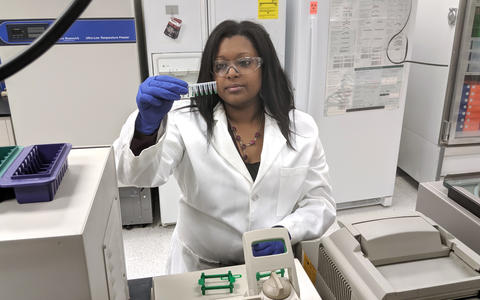
Genome Editing Program leader Samantha Maragh inspects vials of genetic material.
We started from the bottom and now we’re here — geneticist and molecular biologist Samantha Maragh brought NIST into a revolution for the biomedical sciences when it was only at its origins, putting the value of standards front and center in everyone's minds.
It all started with bacteria, specifically bacteria with genomic elements called CRISPR, along with a protein called Cas9.
These particular bacteria, as Max Planck Society’s Emmanuelle Charpentier and UC Berkeley’s Jennifer Doudna discovered, could fight off viral infections in a unique way. When the bacteria encounter a virus, they cut and store pieces of the virus’s DNA within their own genome. If they meet that same virus again, they can recognize the DNA implanted in themselves and cut the invading virus just at that specific site.
The revelation, for which the two researchers recently won a Nobel Prize, was in the concept of reproducing that CRISPR/Cas9 targeted cutting in other cells. If we could intentionally break our DNA at a location where it had a mutation (for example, the mutation that causes sickle cell disease), maybe that DNA could repair itself to permanently eliminate the mutation and prevent or cure the disease.
At the time that discovery caused a buzz among scientists and academics alike, Samantha was pursuing her Ph.D. at Johns Hopkins Medicine while serving as a NIST technician. Laurie Locascio and Willie May, two members of her leadership team at NIST, had previously encouraged Samantha to obtain her doctorate and bring back what she learned to further NIST programs in the biosciences.
That’s just what Samantha did, as she started to envision the potential impact of genome editing technologies such as CRISPR.
It’s no easy feat to convince colleagues that a technology almost nobody had heard of would warrant its own program, but Samantha built a network of key players in the field and made a powerful case for NIST’s role in it, too.
Scientists at the time flew blind without ways to verify whether the techniques they used were actually working. Cells naturally repaired the genetic code that researchers broke, but not always in the way those researchers wanted. And CRISPR itself created problems in need of solving that hadn't existed before for other genome-editing techniques.
As researchers around the globe started to experiment with the new genome-editing approach, it became apparent that NIST definitely had a role. We could provide control samples and datasets to evaluate the test methods and tools of this new trade, and we could standardize the terminology that researchers use so that we all speak the same language.
Thus, a program was born and continues to flourish. NIST joined roundtables with experts from leading health research organizations, and the Genome Editing Consortium that Samantha now leads is making headway toward international standards in the rapidly evolving world of CRISPR and other genome-editing technologies.
Find more information about Samantha’s role in standards development for genome editing in this article from CRISPR Medicine News.
Follow us on social media for more like this from all across NIST!

